Abstract
The interaction between Mycoplasma hyopneumoniae and Pasteurella multocida in experimental pneumonia was investigated in conventional pigs. The experimental animals were 49 days old when inoculated with M. hyopneumoniae; they were inoculated with P. multocida after 23 days, and killed 13 days later. In pigs inoculated only with P. multocida, clinical signs and lung lesions were not observed, and the agent was not recovered. Pigs inoculated with M. hyopneumoniae developed fever, moderate cough and dyspnea which tended to disappear, and small proliferative lung lesions from which M. hyopneumoniae was isolated. Pigs inoculated with both agents had higher fever, severe cough and dyspnea which tended to aggravate, and extensive exudative lung lesions from which organisms were isolated. All animals had similar growth rates, but the group infected with both agents consumed 60% more food. Therefore, M. hyopneumoniae causes mild pneumonia, whereas P. multocida is not pathogenic alone but aggravates the pneumonia initiated by M. hyopneumoniae.
Full text
PDF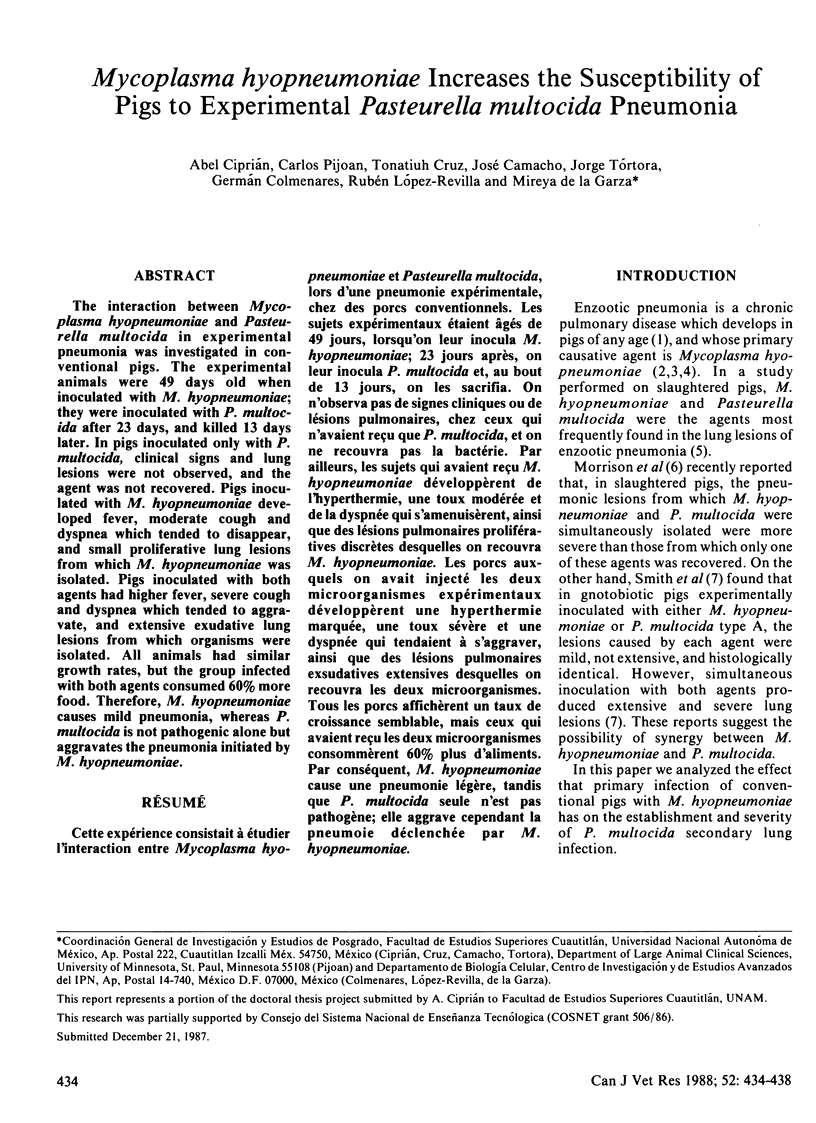
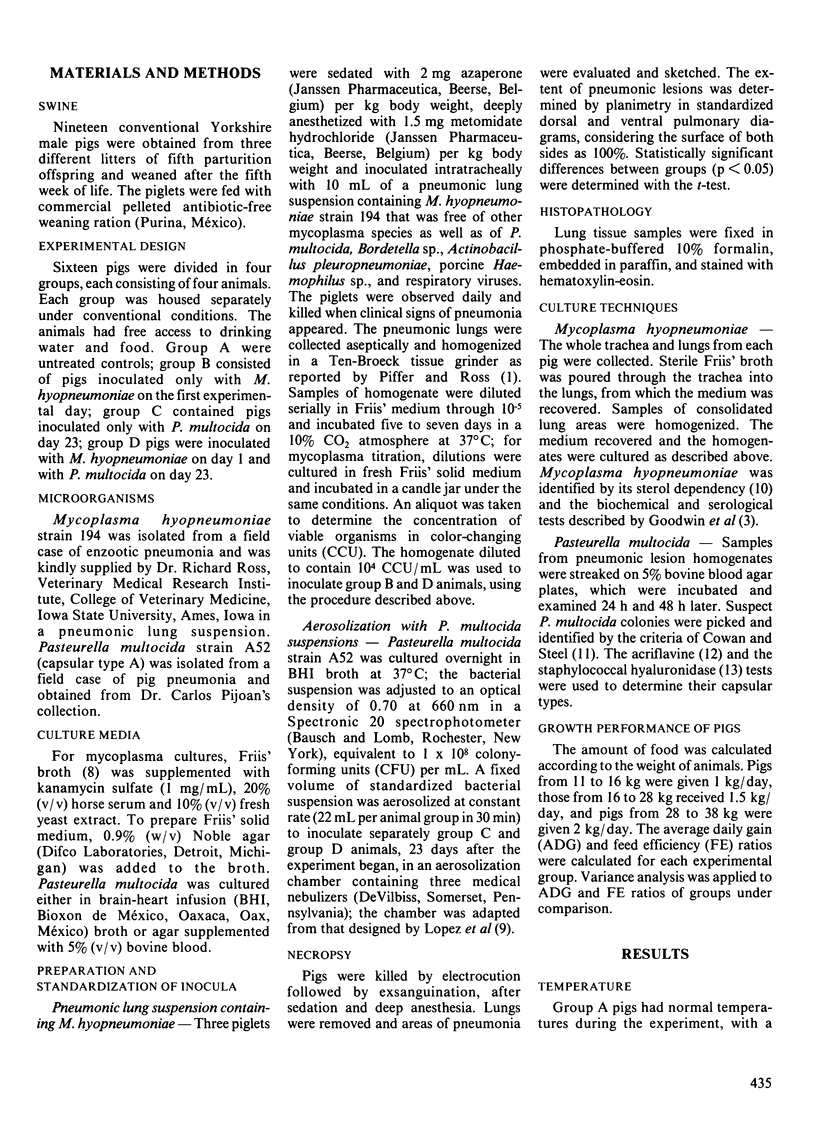
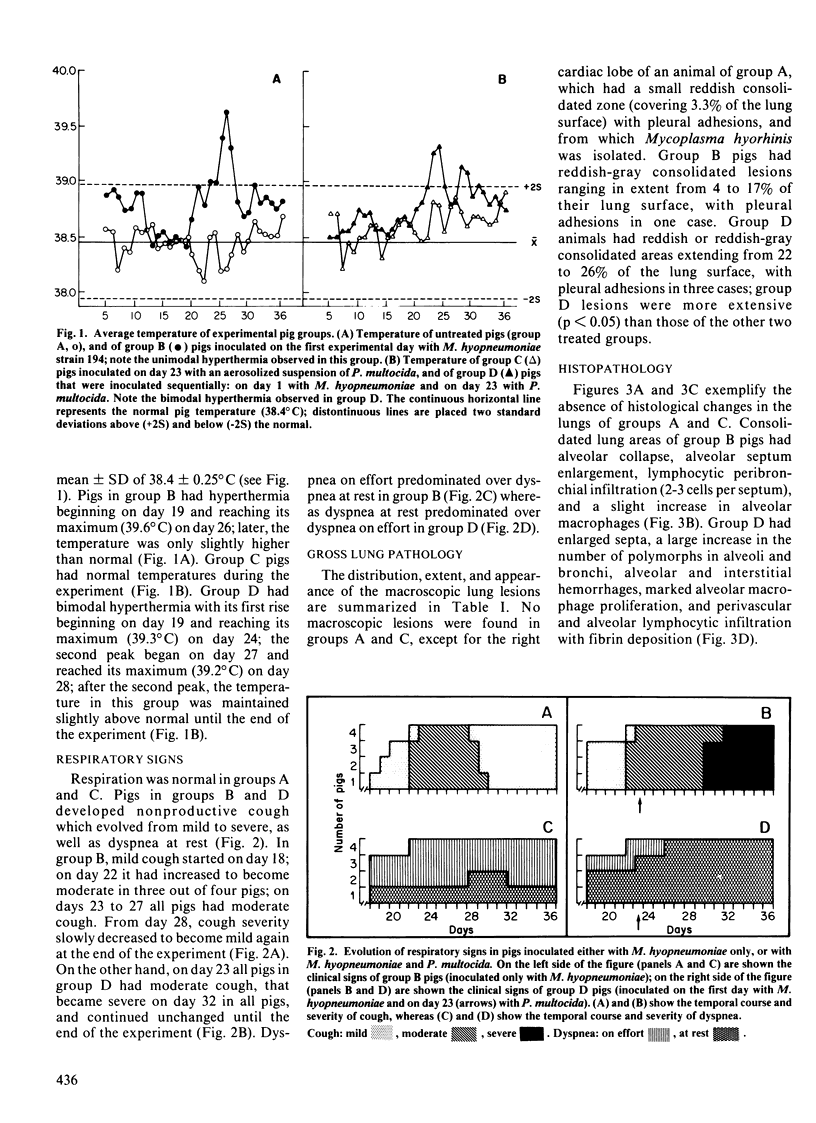
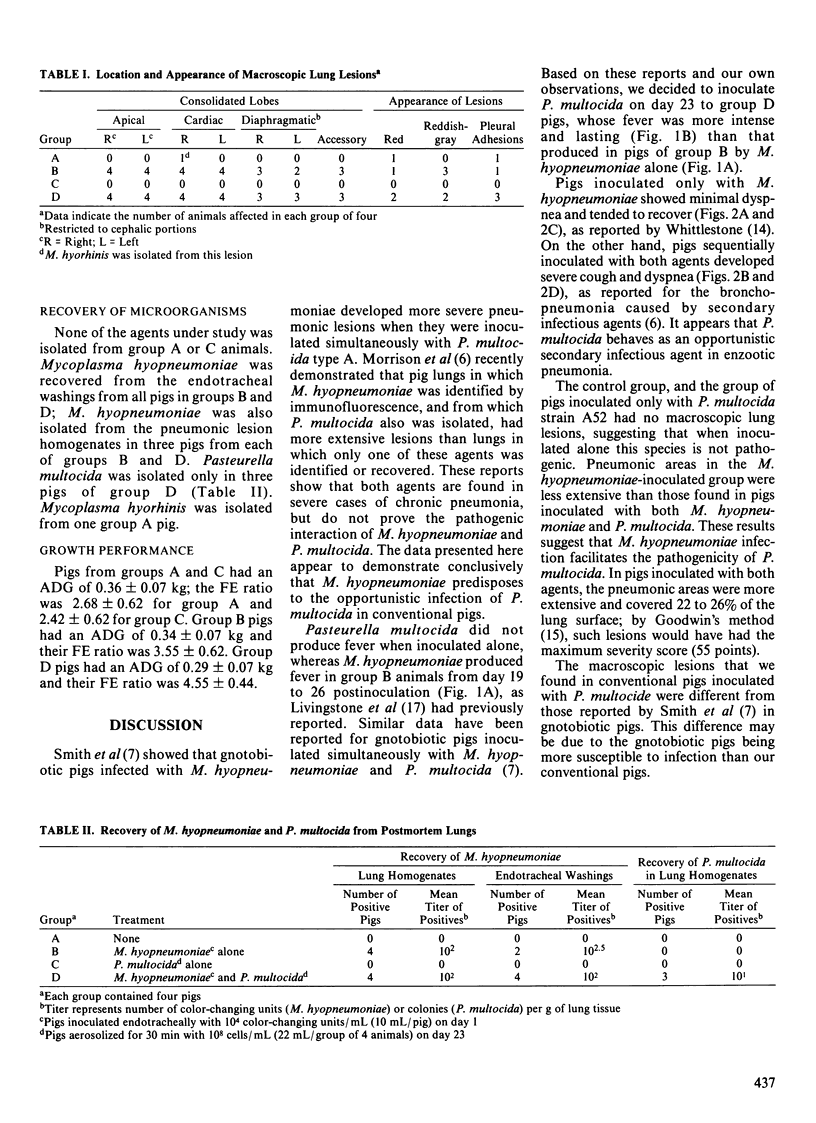
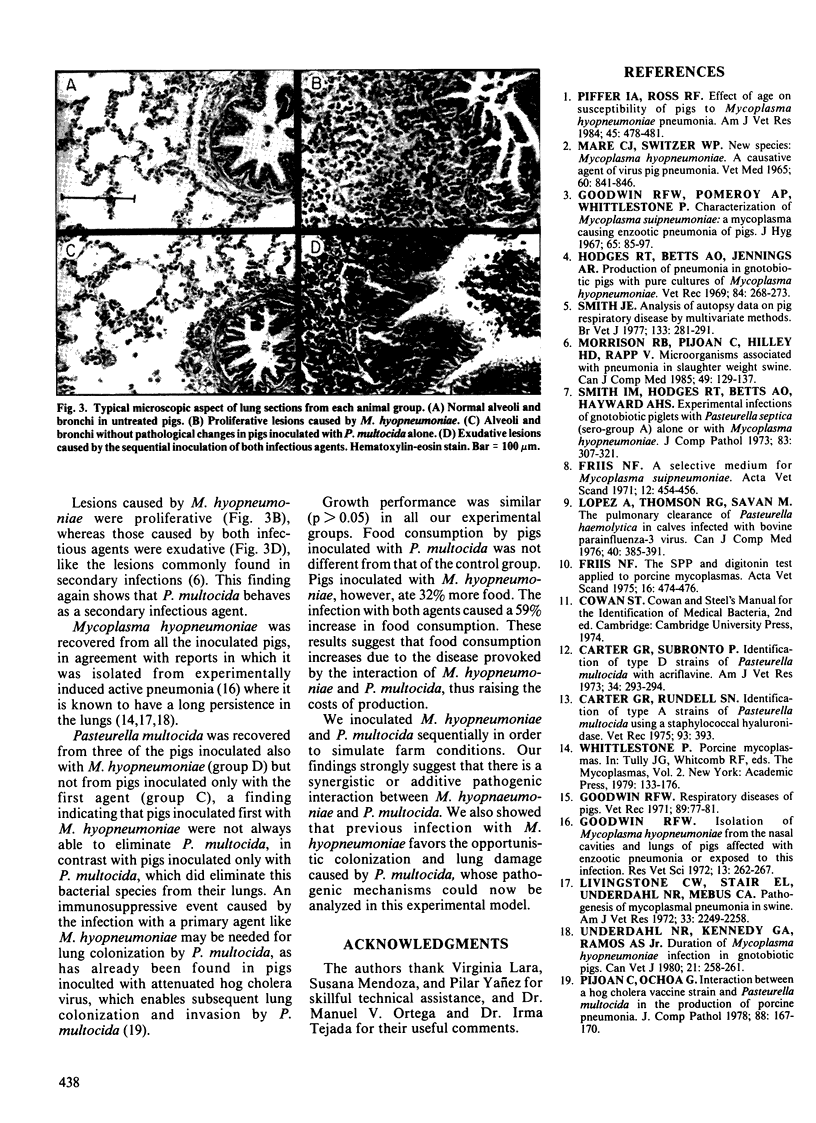
Images in this article
Selected References
These references are in PubMed. This may not be the complete list of references from this article.
- Carter G. R., Subronto P. Identification of type D strains of Pasteurella multocida with acriflavine. Am J Vet Res. 1973 Feb;34(2):293–294. [PubMed] [Google Scholar]
- Friis N. F. The SPS and digitonin tests applied to porcine mycoplasmas. Acta Vet Scand. 1975;16(3):474–476. doi: 10.1186/BF03546667. [DOI] [PMC free article] [PubMed] [Google Scholar]
- Friis N. A selective medium for Mycoplasma suipneumoniae. Acta Vet Scand. 1971;12(3):454–456. doi: 10.1186/BF03547746. [DOI] [PMC free article] [PubMed] [Google Scholar]
- Goodwin R. F. Isolation of Mycoplasma suipneumoniae from the nasal cavities and lungs of pigs affected with enzootic pneumonia or exposed to this infecion. Res Vet Sci. 1972 May;13(3):262–267. [PubMed] [Google Scholar]
- Goodwin R. F., Pomeroy A. P., Whittlestone P. Characterization of Mycoplasma suipneumonia: a mycoplasma causing enzootic pneumonia of pigs. J Hyg (Lond) 1967 Mar;65(1):85–96. doi: 10.1017/s0022172400045563. [DOI] [PMC free article] [PubMed] [Google Scholar]
- Goodwin R. F. The economics of enzootic pneumonia. Vet Rec. 1971 Jul 17;89(3):77–81. doi: 10.1136/vr.89.3.77. [DOI] [PubMed] [Google Scholar]
- Hodges R. T., Betts A. O., Jennings A. R. Production of pneumonia in gnotobiotic pigs with pure cultures of mycoplasma hyopneumoniae. Vet Rec. 1969 Mar 15;84(11):268–273. doi: 10.1136/vr.84.11.268. [DOI] [PubMed] [Google Scholar]
- Livingston C. W., Jr, Stair E. L., Underdahl N. R., Mebus C. A. Pathogenesis of mycoplasmal pneumonia in swine. Am J Vet Res. 1972 Nov;33(11):2249–2258. [PubMed] [Google Scholar]
- Lopez A., Thomson R. G., Savan M. The pulmonary clearance of Pasteurella hemolytica in calves infected with bovine parainfluenza-3 virus. Can J Comp Med. 1976 Oct;40(4):385–391. [PMC free article] [PubMed] [Google Scholar]
- MARE C. J., SWITZER W. P. NEW SPECIES: MYCOPLASMA HYOPNEUMONIAE; A CAUSATIVE AGENT OF VIRUS PIG PNEUMONIA. Vet Med Small Anim Clin. 1965 Aug;60:841–846. [PubMed] [Google Scholar]
- Morrison R. B., Pijoan C., Hilley H. D., Rapp V. Microorganisms associated with pneumonia in slaughter weight swine. Can J Comp Med. 1985 Apr;49(2):129–137. [PMC free article] [PubMed] [Google Scholar]
- Piffer I. A., Ross R. F. Effect of age on susceptibility of pigs to Mycoplasma hyopneumoniae pneumonia. Am J Vet Res. 1984 Mar;45(3):478–481. [PubMed] [Google Scholar]
- Pijoan C., Ochoa G. Interaction between a hog cholera vaccine strain and Pasteurella multocida in the production of porcine pneumonia. J Comp Pathol. 1978 Apr;88(2):167–170. doi: 10.1016/0021-9975(78)90020-8. [DOI] [PubMed] [Google Scholar]
- Smith I. M., Hodges R. T., Betts A. O., Hayward A. H. Experimental infections of gnotobiotic piglets with Pasteurella septica (sero-group A) alone or with Mycoplasma hyopneumoniae. J Comp Pathol. 1973 Jul;83(3):307–321. doi: 10.1016/0021-9975(73)90055-8. [DOI] [PubMed] [Google Scholar]
- Underdahl N. R., Kennedy G. A., Ramos A. S., Jr Duration of Mycoplasma hyopneumoniae infection in gnotobiotic pigs. Can Vet J. 1980 Sep;21(9):258–261. [PMC free article] [PubMed] [Google Scholar]



